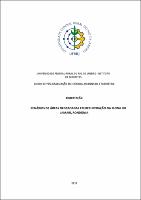| ???jsp.display-item.social.title??? |


|
Please use this identifier to cite or link to this item:
https://tede.ufrrj.br/jspui/handle/jspui/2232| ???metadata.dc.type???: | Dissertação |
| Title: | Cenários de áreas degradadas em recuperação na FLONA do Jamari/RO |
| ???metadata.dc.creator???: | Booth, Micael Cortopassi  |
| ???metadata.dc.contributor.advisor1???: | Francelino, Márcio Rocha |
| First advisor-co: | Mendonça, Bruno Araujo Furtado de |
| ???metadata.dc.contributor.referee1???: | Francelino, Márcio Rocha |
| ???metadata.dc.contributor.referee2???: | Silva, Eduardo Vinicius da |
| ???metadata.dc.contributor.referee3???: | Debiasi, Paula |
| ???metadata.dc.contributor.referee4???: | Carvalho Junior, Waldir |
| ???metadata.dc.description.resumo???: | A utilização de geotecnologias auxilia no acompanhamento e quantificação do desenvolvimento e modificação da paisagem. A região Amazônica tem alta diversidade e riqueza vegetal e é nesse bioma que está a área de estudo, na Florestal Nacional do Jamari, uma Unidade de Conservação de uso múltiplo. Nessa FLONA há oito minas sob um PRAD pois houve desde a década de 1960 a exploração e lavra de cassiterita para obtenção de estanho. A abertura de cavas para a exploração é feita a céu aberto, realizada de forma quase toda mecânica, ficando o ambiente ao final muito degradado e sua restauração demanda recursos e tempo. De modo geral, a recuperação da paisagem de uma área de lavra é feita com o uso de plantio de espécies heterogenias do mesmo bioma, visando recobrir o solo e induzir a regeneração natural. Nas áreas de minas o tipo de substrato influencia no desenvolvimento e fixação das espécies vegetais na área. Os objetivos foram mapear a cobertura do solo, a criação de cenários futuros de revegetação usando um programa de predição. Nestas minas foram mapeados os tipos de substratos que são classificadas em piso de lavra (PL), rejeito seco (RS), rejeito úmido (RU), rejeito capeado e washing plant (WP). Utilizando quatro imagens de alta resolução espacial dos anos 2009, 2011, 2013 e 2015, foram classificados as tipologias solo exposto, campo sujo, capoeira, vegetação rala, intermediária, densa. As áreas ocupadas por cada tipologia, para cada um dos anos estudados nas minas foram comparados visando quantificar as áreas convertidas de solo exposto em áreas vegetadas e a dinâmica da cobertura vegetal presente. Cenários futuros para os anos de 2020 a 2065 foram modelados utilizando o Dinâmica-EGO, programa utilizado para simulação e predição de ambientes naturais em especial desmatamento. A validação dos mapas gerados foi feita utilizando similaridade fuzzy. Os resultados obtidos para os cenários futuros foram em similares ao observado e a dinâmica das cinco tipologias utilizadas evoluíram de forma condizente com o observado, tendo algumas minas melhor desenvolvimento em um menor tempo de acordo com o tipo de substrato e idade dos plantios. |
| Abstract: | The use of geotechnologies assists in the monitoring and quantification of the development and modification of the landscape. The Amazon region has high diversity and plant richness and it is in this biome that is the study area, in the National Forest of Jamari, is a Conservation Unit of Multiple Use. In this FLONA there are eight mines under a PRAD because there has been since the 1960s the exploration and mining of cassiterite to obtain tin. The opening of cavas for the exploration is done in the open, performed almost mechanically, leaving the environment at the end very degraded and its restoration demands resources and time. In general, the recovery of the landscape of an area of cultivation is done with the use of planting heterogenous species of the same biome, aiming to cover the soil and induce natural regeneration. In the areas of mines the type of substrate influences in the development and fixation of the vegetal species in the area. The objectives were to map the soil cover, the creation of future scenarios of revegetation using a prediction program. In these mines the types of substrates that were classified in tillage (PL), dry tail (RS), wet tail (RU), washed tail and washing plant (WP) were mapped. Using four high spatial resolution images of the years 2009, 2011, 2013 and 2015, the typologies were classified as soil exposed, field dirty, capoeira, vegetation thin, intermediate, dense. The areas occupied by each typology for each of the years studied in the mines were compared in order to quantify the converted areas of exposed soil in vegetated areas and the dynamics of the present vegetation cover. Future scenarios for the years 2020 to 2065 were modeled using the Dinamica-EGO, a program used for simulation and prediction of natural environments in particular deforestation. The validation of the generated maps was done using fuzzy similarity. The results obtained for the future scenarios were similar to those observed and the dynamics of the five typologies used evolved in a manner consistent with that observed, with some mines having a better development in a shorter time according to the type of substrate and age of the plantations. |
| Keywords: | forest modeling futures scenes mining PRAD modelagem vegetal Dinâmica-EGO cenários futuros mineração |
| ???metadata.dc.subject.cnpq???: | Ecologia |
| Language: | por |
| ???metadata.dc.publisher.country???: | Brasil |
| Publisher: | Universidade Federal Rural do Rio de Janeiro |
| ???metadata.dc.publisher.initials???: | UFRRJ |
| ???metadata.dc.publisher.department???: | Instituto de Florestas |
| ???metadata.dc.publisher.program???: | Programa de Pós-Graduação em Ciências Ambientais e Florestais |
| Citation: | BOOTH, Micael Cortopassi. Cenários de áreas degradadas em recuperação na FLONA do Jamari/RO. 2017. 81 f. Dissertação (Mestrado em Ciências Ambientais e Florestais, Conservação da Natureza) - Instituto de Florestas, Departamento de Ciências Ambientais, Universidade Federal Rural do Rio de Janeiro, Seropédica, 2017. |
| ???metadata.dc.rights???: | Acesso Aberto |
| URI: | https://tede.ufrrj.br/jspui/handle/jspui/2232 |
| Issue Date: | 22-Feb-2017 |
| Appears in Collections: | Mestrado em Ciências Ambientais e Florestais |
Files in This Item:
| File | Description | Size | Format | |
|---|---|---|---|---|
| 2017 - Micael Cortopassi Booth.pdf | Documento principal | 3.03 MB | Adobe PDF |  Download/Open Preview |
Items in DSpace are protected by copyright, with all rights reserved, unless otherwise indicated.




